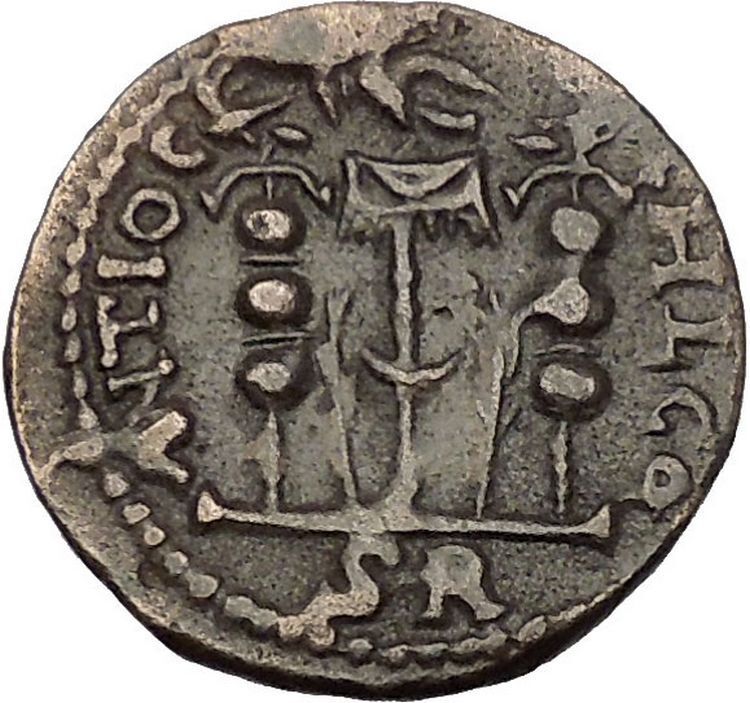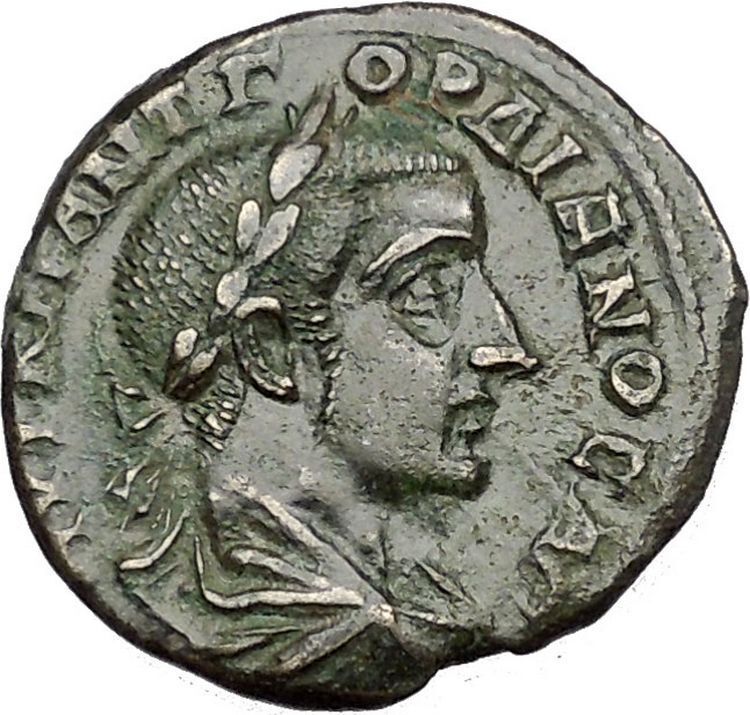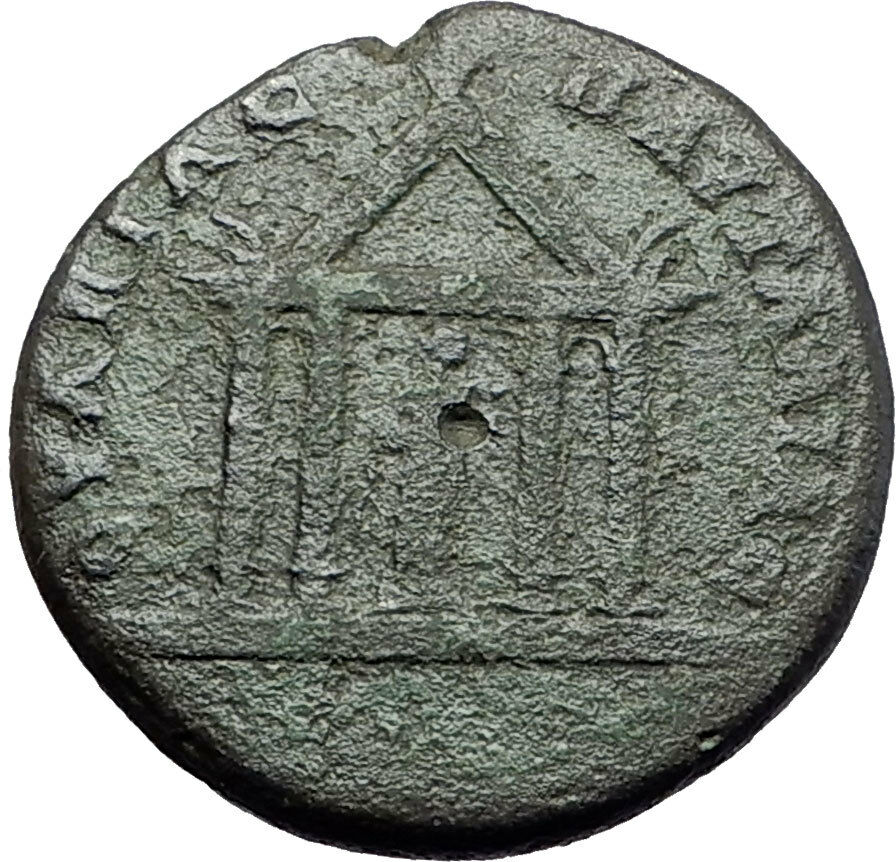|
Philip I ‘the Arab’
–
Roman Emperor
: 244-249 A.D. –
Bronze ‘Sestertius’ 27mm (19.62 grams) from Year 5 of the founding of
Viminacium
= ANV = 243/4 A.D.
IMP M IVL PHILIPPVS AVG, laureate, draped & curiassed bust right.
P M S COL VIM, Moesia standing left between
bull
&
lion
, AN V in ex.
You are bidding on the exact item pictured,
provided with a Certificate of Authenticity and Lifetime Guarantee of
Authenticity.
Legio septima Claudia Pia Fidelis (Seventh Claudian
Legion) was a
Roman legion
. Its emblem, as well as of all Caesar’s legions, was the bull,
together with the lion.[citation
needed]
The 7th, along with the
6th
,
8th
&
9th
were all founded by Pompey in Spain in 65 BC.
They were ordered to
Cisalpine Gaul
around 58 BC by
Julius Caesar
, and marched with him throughout the entire Gallic Wars.
Legio VII was one of the two legions used in
Caesar’s invasions of Britain
, and played a crucial role in The
Battle of Pharsalus
in 48 BC, and it existed at least until the end of the
4th century, guarding middle
Danube
.
Tiberius Claudius Maximus
the Roman soldier who brought the head of
Decebalus
to emperor
Trajan
was serving in Legio VII Claudia.
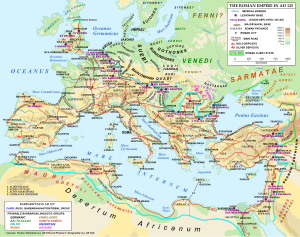
Map of the Roman empire in AD 125, under emperor
HadrianLegio VII Claudia, stationed on the river
Danube
at
Viminacium
(Kostolac, Serbia), in
Moesia Superior
province, from AD 58 until the 4th century
Viminacium (VIMINACIVM) was a major city (provincial
capital) and military camp of the
Roman
province of
Moesia
(today’s
Serbia
), and the capital of
Moesia Superior
. The site is located 12 km
from the modern town of
Kostolac
in Eastern Serbia. The city dates back
to the 1st century AD, and at its peak it is believed to have had 40.000
inhabitants, making it one of the biggest cities of that time. It lies on the
Roman road
Via Militaris
. Viminacium was devastated by
Huns in the 5th century, but was later rebuilt by
Justinian
. It was completely destroyed with the
arrival
of
Slavs
in the 6th century. Today, the
archeological site occupies a total of 450 hectares, and contains remains of
temples, streets, squares, amphitheatres, palaces, hippodromes and Roman baths.
History

A XXV the scene of the
Trajan’s Column
, which may have
been accounted for “headquarters” of the Roman Emperor: Viminacium.
The remains of Viminacium, the capital of the Roman province of
Moesia Superior
, are located on territories of
the villages of Stari Kostolac and Drmno, about 12 km from the town of
Kostolac
and about 90 miles southeast of
Belgrade
. Viminacium was one of the most
important Roman cities and military camps in the period from 1st to 4th
centuries. Its exceptional strategic importance was reflected both in the
defense of the northern border of the Roman empire and in turn of communications
and commercial transactions. No less appealing to the Romans was the hinterland
of the Mlava
river valley, which is rich in ore and
grains. In Roman times, the town on the northern side of relying directly on the
branch of the Danube
, while the western side, touching the
walls Mlava rivers. Only in the later period, Viminacium spread to the left bank
of Mlava. Thanks to the location, land and waterways, Viminacium represented one
of those areas where the encounter of cultures between East and West was
inevitable. Although these roads were the primary military and strategic
function, they are taking place throughout antiquity very lively traffic and
certainly contributed to the very Viminacium become prosperous and an important
trading and business headquarters. In Viminacium,
Roman legion VII Claudia
was stationed, and a
nearby civilian settlement emerged from the military camp. In 117 during the
reign of Hadrian
it received city status. In the camp,
6.000 soldiers were stationed, and 30-40.000 lived nearby. In the first half of
the 3rd century the city was in full development, as evidenced by the fact that
at that time it acquired the status of a Roman colony, and the right to coin
local money. Here, in 211,
Septimius Severus
was proclaimed emperor by his
son Caracalla
. In the mausoleum and the excavated
tombs, the Roman emperor
Hostilian
, who died in 251, was buried.
A legion may have been stationed here as early as Augustus (27 BC-14 AD). In
33/34 AD a road was built, linking Viminacium and
Ratiaria
.
Claudius
(41-54) garrisoned Viminacium,
Oescus
and
Novae
as camps for the Moesian legions.
The first legion attested at Viminacium was the VII Claudia that came from
Dalmatia in 52 AD .
Emperor Trajan
(98-117) was headquartered here
during the
Dacian Wars
. It became a colonia with
minting privilege in 239 AD during the rule of
Gordian III
(238-244) and housed the Legion VII
and Legion IV.
Emperor Hostilian
was the son of the emperor
Decius
, who was killed in the ambush near the
ancient city of Abrutus located in present day Bulgaria. According to the old
manuscript, emperor Hostilian and his mother came to Viminacium to supervise the
organization of defense of northern borders, but both of them died of the
plague. Because of the distance and the fear of spreading the plague, he was
buried with all honors in Viminacium
Viminacium was the provincial capital of
Moesia Superior
. In the late spring of 293-294,
Diocletian
journeyed through his realm and he
re-organized Viminacium as the capital of the new province of Moesia Superior
Margensis. He registered that the people wrote in Latin, as opposed to Greek
in the southern provinces. Viminacium was the base camp of
ClaudiaLegio VII
,
and hosted for some time the
Flavia FelixIIII
.
It had a Roman amphitheatre with room for 12,000 people.
In 382 the city was the meeting place between
Theodosius
and
Gratian
amidst the
Gothic Wars
.
Viminacium was destroyed in 441 by the
Attila the Hun
, but rebuilt by
Justinian I
. During
Maurice’s Balkan campaigns
, Viminacium saw
destruction by the
Avars
in 582 and a
crushing defeat
of Avar forces on the northern
Danube bank in 599, destroying Avar reputation for invincibility.[3]
Location and
excavation

Valerian
AD 253-260. AR
Antoninianus. Viminacium mint. 1st emission, 1st phase, AD 253.
Viminacium is located in
Stari Kostolac
(Old
Kostolac
) a
Serbian
town on the
Danube
river, east of
Belgrade
. Viminacium is the location of the
first archaeological excavation in Serbia, which started in 1882, by
Mihailo Valtrović
, an architect by profession
and the first professor of archeology at the college in
Belgrade
. The only help he received was from 12
prisoners, because the state did not have enough resources to provide him with a
better work force. His research was continued by
Miloje Vasić
, in the 1970s[clarification
needed]. It has intensified in the last ten years in
the area of the Roman city of the Roman legionary camps and cemeteries. Many
studies suggest that the military camp at Viminacium had a rectangular plan,
measuring 442 x 385 meters, and that is not far from its western wall of
civilian settlement in an area of approximately 72 acres. Legionary camp in
Viminacium is now in a layer of arable land, so that wealth Viminacium easily
accessible to researchers, but, unfortunately, and the robbers.The National
Museum in Belgrade
and
Požarevac
kept some 40,000 items found in
Viminacium, of which over 700 made of gold and silver. Among them are many
objects that represent the European and world rarities invaluable.
It has been discovered and more than 13,500 graves. Tombstones and sarcophagi
are often decorated with relief representations of scenes from mythology or
daily life. We have found numerous grave masonry construction. Especially
interesting are the frescoes of the 4th-century tombs.
Fresco
with the notion of young women in
artistic value of the extreme range of late antique art. During the excavation,
an amphitheater, which with its 12,000 seats was one of the largest in the
Balkans
.
Today
Kostolac
, a small
Serbian
town on the
Danube
river, is located where Viminacium used to be.
Marcus
Julius Philippus or Philippus I Arabs (c. 204–249), known in
English
as Philip the Arab or formerly (prior to World War II) in
English as Philip the Arabian, was a
Roman
Emperor
from 244 to 249.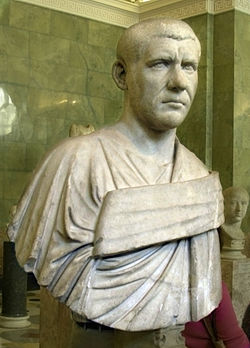
//
Early
life
Little is known about Philip’s early life and political
career. He was born in
Shahba
, about
55 miles southeast of
Damascus
,
in the
Roman province
of
Syria
. Philip has the nickname “the Arab” because he had family who had
originated in the
Arabian peninsula
, believed to be distant descendants of the prestigious
Baleed family of Aleppo
. Philip was the son of a Julius Marinus, a local Roman citizen,
possibly of some importance. Many historians[1][2][3]
agree that he was of Arab descent who gained
Roman citizenship
through his father, a man of considerable influence. Many
citizens from the provinces took Roman names upon acquiring citizenship. This
makes tracing his Arabic blood line difficult. However, it is documented that
Rome used the
Ghassan
tribe from the
Azd of
Yemen
as vassals
to keep the neighboring northern Arabs in check.
The name of Philip’s mother is unknown, but sources refer to
a brother,
Gaius Julius Priscus
, a member of the
Praetorian guard
under
Gordian
III
(238–244). In 234, Philip married
Marcia Otacilia Severa
, daughter of a Roman Governor. They had two children:
a son named Marcus Julius Philippus Severus (Philippus
II) in 238 and according to numismatic evidence they had a daughter called
Julia Severa or Severina, whom the ancient Roman sources don’t mention.
Philip became a member of the
Pretorian Guard
during the reign of the emperor
Alexander Severus
, who was a Syrian. In ancient Rome the Pretorian Guard was
closely associated with the emperor, serving among other things as the emperor’s
bodyguard.
Political
career
In 243, during
Gordian
III
‘s campaign against
Shapur I
of
Persia, the
Praetorian prefect
Timesitheus
died under unclear circumstances. At the suggestion of his
brother Priscus, Philip became the new Praetorian prefect, with the intention
that the two brothers would control the young Emperor and rule the Roman world
as unofficial regents. Following a military defeat, Gordian III died in 244
under circumstances that are still debated. While some claim that Philip
conspired in his murder, other accounts (including one coming from the Persian
point of view) state that Gordian died in battle. Whatever the case, Philip
assumed the purple following Gordian’s death. According to Edward Gibbon:
His rise from so obscure a station to the first dignities
of the empire seems to prove that he was a bold and able leader. But his
boldness prompted him to aspire to the throne, and his abilities were
employed to supplant, not to serve, his indulgent master.
Philip was not willing to repeat the mistakes of previous
claimants, and was aware that he had to return to
Rome in order to
secure his position with the
senate
. He thus travelled west, after concluding a peace treaty with Shapur
I, and left his brother Priscus as extraordinary ruler of the Eastern provinces.
In Rome he was confirmed
Augustus
, and nominated his young son
Caesar
and heir.
Philip’s rule started with yet another
Germanic
incursion on the provinces of
Pannonia
and the Goths
invaded Moesia
(modern-day Serbia
and Bulgaria
)
in the Danube
frontier. They were finally defeated in the year 248, but the
legions
were not satisfied with the result, probably due to a low share of the plunder,
if any. Rebellion soon arose and
Tiberius
Claudius Pacatianus
was proclaimed emperor by the troops. The uprising was
crushed and Philip nominated
Gaius Messius
Quintus Decius
as governor of the province. Future events would prove this
to be a mistake. Pacatianus’ revolt was not the only threat to his rule: in the
East, Marcus Jotapianus
led another uprising in response to the oppressive rule of
Priscus
and the excessive taxation of the Eastern provinces. Two other
usurpers, Marcus Silbannacus
and
Sponsianus
,
are reported to have started rebellions without much success.
In April
A.D.
248 (April 1000
A.U.C.
), Philip had the honour of leading the celebrations of the one
thousandth birthday of Rome, which according to tradition was
founded
in 753 BC by
Romulus
. He combined the anniversary with the celebration of Rome’s alleged
tenth saeculum
.
According to contemporary accounts, the festivities were magnificent and
included spectacular games,
ludi saeculares
, and theatrical presentations throughout the city. In the
coliseum, more than 1,000 gladiators were killed along with hundreds of exotic
animals including hippos, leopards, lions, giraffes, and one rhinoceros.
The events were also celebrated in literature, with several publications,
including
Asinius Quadratus
‘s History of a Thousand Years, specially prepared
for the anniversary.
Despite the festive atmosphere, discontent in the legions was
growing. Decius
(249–251) was proclaimed Emperor by the Danubian armies in the spring of 249 and
immediately marched to Rome. Philip’s army met the usurper near modern
Verona
that summer. Decius won the battle and Philip was killed sometime in
September 249,
either in the fighting or assassinated by his own soldiers who were eager to
please the new ruler. Philip’s eleven-year-old son and heir may have been killed
with his father and Priscus disappeared without a trace.
Religious
beliefs
Further information:
Philip the Arab and Christianity
Some later traditions, first mentioned in the historian
Eusebius
in his
Ecclesiastical History
, held that Philip was the first
Christian
Roman emperor. This tradition seems to be based on reports in
Eusebius that Philip allegedly had once entered a Christian service on Easter,
after having been required by a bishop to confess his sins. Later versions
located this event in Antioch.
However, historians generally identify the later Emperor
Constantine, baptised on his deathbed, as the first Christian emperor, and
generally describe Philip’s adherence to Christianity as dubious, because
non-Christian writers do not mention the fact, and because throughout his reign,
Philip to all appearances (coinage, etc.) continued to follow the
state religion
.
Critics ascribe Eusebius’ claim as probably due to the tolerance Philip showed
towards Christians.
Saint Quirinus of Rome
was, according to a legendary account, the son of
Philip the Arab.
The sestertius, or sesterce, (pl. sestertii) was an
ancient Roman
coin. During the
Roman Republic
it was a small,
silver
coin issued only on rare occasions.
During the
Roman Empire
it was a large
brass
coin.

Helmed Roma head right, IIS behind
Dioscuri
riding right, ROMA in linear frame
below. RSC4, C44/7, BMC13.
The name sestertius (originally semis-tertius) means “2 ½”, the
coin’s original value in
asses
, and is a combination of semis
“half” and tertius “third”, that is, “the third half” (0 ½ being the
first half and 1 ½ the second half) or “half the third” (two units
plus half the third unit, or halfway between the second unit and
the third). Parallel constructions exist in
Danish
with halvanden (1 ½),
halvtredje (2 ½) and halvfjerde (3 ½). The form sesterce,
derived from
French
, was once used in preference to the
Latin form, but is now considered old-fashioned.
It is abbreviated as (originally IIS).

Example of a detailed portrait of
Hadrian
117 to 138
History
The sestertius was introduced c. 211 BC as a small
silver
coin valued at one-quarter of a
denarius
(and thus one hundredth of an
aureus
). A silver denarius was supposed to
weigh about 4.5 grams, valued at ten grams, with the silver sestertius valued at
two and one-half grams. In practice, the coins were usually underweight.
When the denarius was retariffed to sixteen asses (due to the gradual
reduction in the size of bronze denominations), the sestertius was accordingly
revalued to four asses, still equal to one quarter of a denarius. It was
produced sporadically, far less often than the denarius, through 44 BC.

Hostilian
under
Trajan Decius
250 AD
In or about 23 BC, with the coinage reform of
Augustus
, the denomination of sestertius was
introduced as the large brass denomination. Augustus tariffed the value of the
sestertius as 1/100 Aureus
. The sestertius was produced as the
largest brass
denomination until the late 3rd century
AD. Most were struck in the mint of
Rome but from AD 64 during the reign of
Nero (AD 54–68) and
Vespasian
(AD 69–79), the mint of
Lyon (Lugdunum), supplemented production. Lyon sestertii can
be recognised by a small globe, or legend stop), beneath the bust.[citation
needed]
The brass sestertius typically weighs in the region of 25 to 28 grammes, is
around 32–34 mm in diameter and about 4 mm thick. The distinction between
bronze
and brass was important to the Romans.
Their name for brass
was
orichalcum
, a word sometimes also spelled
aurichalcum (echoing the word for a gold coin, aureus), meaning
‘gold-copper’, because of its shiny, gold-like appearance when the coins were
newly struck (see, for example
Pliny the Elder
in his Natural History
Book 34.4).
Orichalcum
was considered, by weight, to be
worth about double that of bronze. This is why the half-sestertius, the
dupondius
, was around the same size and weight
as the bronze as, but was worth two asses.
Sestertii continued to be struck until the late 3rd century, although there
was a marked deterioration in the quality of the metal used and the striking
even though portraiture remained strong. Later emperors increasingly relied on
melting down older sestertii, a process which led to the zinc component being
gradually lost as it burned off in the high temperatures needed to melt copper (Zinc
melts at 419 °C, Copper
at 1085 °C). The shortfall was made up
with bronze and even lead. Later sestertii tend to be darker in appearance as a
result and are made from more crudely prepared blanks (see the
Hostilian
coin on this page).
The gradual impact of
inflation
caused by
debasement
of the silver currency meant that
the purchasing power of the sestertius and smaller denominations like the
dupondius and as was steadily reduced. In the 1st century AD, everyday small
change was dominated by the dupondius and as, but in the 2nd century, as
inflation bit, the sestertius became the dominant small change. In the 3rd
century silver coinage contained less and less silver, and more and more copper
or bronze. By the 260s and 270s the main unit was the double-denarius, the
antoninianus
, but by then these small coins
were almost all bronze. Although these coins were theoretically worth eight
sestertii, the average sestertius was worth far more in plain terms of the metal
they contained.
Some of the last sestertii were struck by
Aurelian
(270–275 AD). During the end of its
issue, when sestertii were reduced in size and quality, the
double sestertius
was issued first by
Trajan Decius
(249–251 AD) and later in large
quantity by the ruler of a breakaway regime in the West called
Postumus
(259–268 AD), who often used worn old
sestertii to
overstrike
his image and legends on. The double
sestertius was distinguished from the sestertius by the
radiate crown
worn by the emperor, a device
used to distinguish the dupondius from the as and the antoninianus from the
denarius.
Eventually, the inevitable happened. Many sestertii were withdrawn by the
state and by forgers, to melt down to make the debased antoninianus, which made
inflation worse. In the coinage reforms of the 4th century, the sestertius
played no part and passed into history.
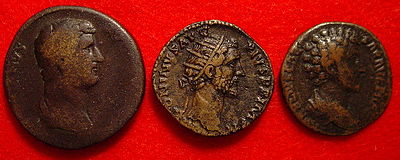
Sestertius of
Hadrian
, dupondius of
Antoninus Pius
, and as of
Marcus Aurelius
As a unit of account
The sestertius was also used as a standard unit of account, represented on
inscriptions with the monogram HS. Large values were recorded in terms of
sestertium milia, thousands of sestertii, with the milia often
omitted and implied. The hyper-wealthy general and politician of the late Roman
Republic,
Crassus
(who fought in the war to defeat
Spartacus
), was said by Pliny the Elder to have
had ‘estates worth 200 million sesterces’.
A loaf of bread cost roughly half a sestertius, and a
sextarius
(~0.5 liter) of
wine anywhere from less than half to more than 1 sestertius. One
modius
(6.67 kg) of
wheat
in 79 AD
Pompeii
cost 7 sestertii, of
rye
3 sestertii, a bucket 2 sestertii, a tunic 15 sestertii, a donkey 500 sestertii.
Records from Pompeii
show a
slave
being sold at auction for 6,252
sestertii. A writing tablet from
Londinium
(Roman
London
), dated to c. 75–125 AD, records the
sale of a Gallic
slave girl called Fortunata for 600
denarii, equal to 2,400 sestertii, to a man called Vegetus. It is difficult to
make any comparisons with modern coinage or prices, but for most of the 1st
century AD the ordinary
legionary
was paid 900 sestertii per annum,
rising to 1,200 under
Domitian
(81-96 AD), the equivalent of 3.3
sestertii per day. Half of this was deducted for living costs, leaving the
soldier (if he was lucky enough actually to get paid) with about 1.65 sestertii
per day.
Perhaps a more useful comparison is a modern salary: in 2010 a private
soldier in the US Army (grade E-2) earned about $20,000 a year.
Numismatic value

A sestertius of
Nero
, struck at
Rome
in 64 AD. The reverse depicts
the emperor on horseback with a companion. The legend reads DECVRSIO,
‘a military exercise’. Diameter 35mm
Sestertii are highly valued by
numismatists
, since their large size gave
caelatores (engravers) a large area in which to produce detailed portraits
and reverse types. The most celebrated are those produced for
Nero (54-68 AD) between the years 64 and 68 AD, created by some of
the most accomplished coin engravers in history. The brutally realistic
portraits of this emperor, and the elegant reverse designs, greatly impressed
and influenced the artists of the
Renaissance
. The series issued by
Hadrian
(117-138 AD), recording his travels
around the Roman Empire, brilliantly depicts the Empire at its height, and
included the first representation on a coin of the figure of
Britannia
; it was revived by
Charles II
, and was a feature of
United Kingdom
coinage until the
2008 redesign
.
Very high quality examples can sell for over a million
dollars
at auction as of 2008, but the coins
were produced in such colossal abundance that millions survive.
|














